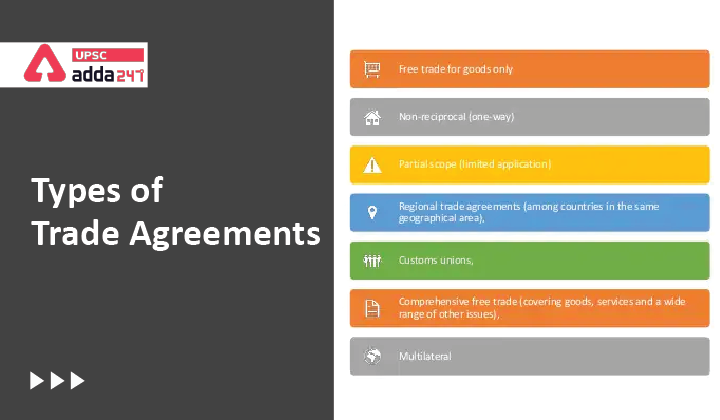Table of Contents
Regional Trade Agreements
The UPSC aspirants often come across with words like FTA, PTA, CEPA, etc while reading newspapers. These similar-sounding words often confuse the aspirants, and hence this article is to assist you in your preparation and help you achieve your goal of clearing UPSC CSE 2022.
What is a trade agreement?
- Trade agreements is an agreement between two or more countries for specific terms of trade, commerce, transit or investment. They mostly involve mutually beneficial concessions, including both trade and non-trade concessions.
Types of Trade Agreements
- There are a few types of trade agreements, depending on the terms and concession agreed on by the participating bodies.
Framework agreement
- Framework agreement primarily defines the scope and provisions of orientation of the potential agreement between the trading partners.
- Framework agreement provides for some new area of discussions and set the period for future liberalisation.
- India has previously signed framework agreements with the ASEAN, Japan etc.
Early Harvest Scheme
- An Early Harvest Scheme (EHS) is a precursor to an FTA/CECA/CEPA between two trading partners.
- For example: early harvest scheme of RCEP has been rolled out. At this stage, the negotiating countries identify certain products for tariff liberalization pending the conclusion of actual FTA negotiations.
- An Early Harvest Scheme is thus a step towards enhanced engagement and confidence building.
Preferential Trade Agreement (PTA)
- PTA is a type of agreement in which two or more partners give preferential right of entry to certain products. This is done by reducing duties on an agreed number of tariff lines.
- In this trade agreement, a positive list is maintained i.e., the list of the products on which the two partners have agreed to provide preferential access.
- Tariff may even be reduced to zero for some products even in a PTA.
- For example: India signed a PTA with Afghanistan and MERCOSUR–a South American trade bloc.
Free Trade Agreement
- A free trade agreement (FTA) is an agreement where two or more countries agree to provide preferential trade terms, tariff concession etc. to the partner country.
- In this agreement, a negative list of products and services is maintained by the negotiating countries on which the terms of FTA are not applicable hence it is more comprehensive than preferential trade agreement.
- India has signed FTA with many countries e.g., Sri Lanka, along with some trading blocs like ASEAN (Association of Southeast Asian Nations).
Comprehensive Economic Partnership Agreement (CEPA)
- Partnership agreement or cooperation agreement are more comprehensive than an FTA.
- CECA/CEPA also looks into the regulatory aspect of trade and encompasses and agreement covering the regulatory issues.
- CECA have the widest coverage. CEPA covers negotiation on the trade in services and investment, and other areas of economic partnership.
- CEPA may even consider negotiation on areas such as trade facilitation and customs cooperation, competition, and IPR (intellectual property rights).
- For example: India has signed CEPAs with South Korea and Japan.
Comprehensive Economic Cooperation Agreement (CECA)
- CECA generally cover negotiation on trade tariff and TQR rates only. It, however, is not as comprehensive as CEPA. India has signed CECA with Malaysia.
Customs Union
- A customs union is an agreement between two or more countries to remove trade barriers and lower or eliminate tariffs. Members of a customs union generally apply a common external tariff on imports from non-member countries.
Economic Union
- An economic union is an agreement between two or more nations to allow goods, services, money and workers to move over borders freely.
- The countries may also coordinate social and financial policies to support this common market. The European Union (EU) is an example of an economic union.



 TSPSC Group 1 Question Paper 2024, Downl...
TSPSC Group 1 Question Paper 2024, Downl...
 TSPSC Group 1 Answer key 2024 Out, Downl...
TSPSC Group 1 Answer key 2024 Out, Downl...
 UPSC Prelims 2024 Question Paper, Downlo...
UPSC Prelims 2024 Question Paper, Downlo...
